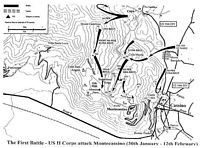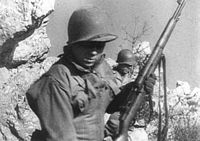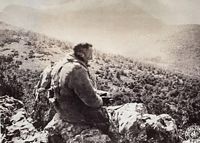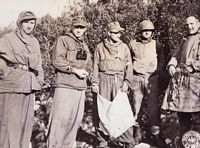Data: 06-08-2005
 Autore: ROBERTO MOLLE
Autore: ROBERTO MOLLE Liste: ARTICLES IN ENGLISH
Liste: ARTICLES IN ENGLISH Categorie: Le battaglie
Categorie: Le battaglie Tag: #febbraio 1944, germania, monte-castellone
Tag: #febbraio 1944, germania, monte-castelloneOPERATION MICHAEL – FEBRUARY 12, 1944
In early February 1944 the first battle of Cassino was in its final phases. Clark's plan was to break through with American troops in order to advance to Cassino. This began with tragedy; the attack of the 36th (Texas) Division on the river Gari did not succeed despite victory appearing possible.
The situation
The 135th Regt., 34th (Red Bull) and the 142nd Regt., 36th (Texas) Division had taken the important Mount Castellone, and from there had occupied Phantom Ridge and Snakeshead Ridge, arriving at Calvary Hill, Point 593. From below, while 133rd Regt., 34th Division tried to enter the city, sections of the 168th Regiment had already arrived at Point 445 and were established below the Monastery, capturing the hidden artillery observation posts in the caves under the Abbey.
Victory looked possible but unfortunately did not come. The arrival of the paratroopers of the 3rd Regt., 1st Fallschimjager Division, allowed the Germans to re-take and hold the vitally important Point 593, rendering useless all the previous American successes in their advance towards the Monastery.
The charge began, with the Americans demonstrating a great courage and determination not previously recognised by the other Allies. However, with the troops having to fight in such unfavourable conditions, many were killed. Added to the dreadful loss of men, both dead and wounded, was a steep, rocky and inhospitable terrain, preventing them from digging trenches and making it difficult to defend themselves easily, while the Germans continually hammered the occupied positions with artillery. The weather was indeed inclement with rain, wind, snow and ice; many soldiers suffering with frostbite. The kitting out of the soldiers also played a part: they were in fact equipped wearing the uniform model 41, little more than a light jacket inadequate for the rigours of the winter. The American units, exhausted, were replaced by the now famous 4th Indian Division that had been covered in glory in North Africa.
If the main objective, to pass through Cassino, had been lost, Clark could however boast a partial but important achievement. All the hilltops behind the Abbey were in Allied hands; they held the better positions that gave the opportunity for a conclusive attack against the Gustav line. Therefore in the early days of February the Americans, above all, held a wide portion of mountainous territory behind the Abbey and Mount Castellone which dominated the other points from its height of 771 meters.
The danger
Early in February General Ernst Gunther Baade, Commander of the 90th Panzergrenadier Division, assumed control of this front and noted the potential danger that came from Mount Castellone: from that point the Allies could have attacked in a westerly direction towards Saint Villa Lucia, and down the wide gorge to Route 6 (Via Casilina), a manoeuvre which would encircle all the German forces, taking the city of Cassino and the Monastery hill; a plan that, in truth, the Allies did not even consider!
The Allies made yet another strategic error in the fighting of the battle of Cassino. One only needed to look at a topographical map of the area to understand that an attack in force carried from Mount Castellone towards the valley, from the dominant and therefore strategically favourable position, could have resulted in the surrounding of the German troops and the end of the battle at Cassino, with a result that would reflect favourably also on the rest of the Italian campaign.
Such a possibility, however, was not taken into consideration and the Allies spent another four months, their multi-ethnic troops bled white, below the Abbey on the slopes of Montecassino, on the mountains behind, and in the city of Cassino.
The Germans felt that this encirclement was a real danger and therefore General Baade, fine strategist that he was, thought that an attack in order to reconquer Mount Castellone was necessary; the code name for this operation was "Operation Michael".
The attack was set for the 9th of February; the date came but the attack was delayed because the paratroopers who were to be used had been relocated to other points of the front. The new date of the 12th of February was set.
The units in the field
The plan the Germans predicted was that the I./ Pz-Gren Regt.200, commanded by Captain Bottler, would have attacked from the ridge west of Mount Castellone in the central part; the III./ Pz-Gren Regt.200, under Captain Heyda, staying on the western side but moving more to the north; finally the IV "HochGebirgsjaeger" (Mountain) Battalion would have moved from the position on S. Angelo Hill in direction of Point 706, passing along the ridge, and reaching Mount Castellone. The Americans were positioned on the slopes behind Mount Castellone; towards the salient mountain were the weaker forces of the 1/142nd Regt in the direction of Point 706 the 3/143rd Regt., finally the 2/141st Regt. was positioned from Point 706 and Point 465, the connection between Phantom Ridge and Snakeshead Ridge; all units of the 36th (Texas) Division.
The Attack
The attack began at 1600 hours on Saturday 12th February. The German artillery comprising 109 guns and mortars, to which 28 nebelwerfer were added, opened fire on Castellone; the shooting lasted until 18.10. Suddenly, the German troops started the attack. From the command point at Saint Villa Lucia
Colonel von Behr,
The attack began at 1600 hours on Saturday 12th February. The German artillery comprising 109 guns and mortars, to which 28 nebelwerfer were added,
opened fire on Castellone; the shooting lasted until 18.10. Suddenly, the German troops started the attack. From the command point at Saint Villa
Lucia Colonel Behr, commander of Panzergrenadier Regt. 200, followed the phases of the attack; in a short time the German soldiers had successfully
reached the mountain top. The German artillery continued to bombard the top of Castellone, now, however, occupied by the German grenadiers; Captain
Munsing radioed unsuccessfully for firing to cease. From the German line soldiers fired a green rocket to signal their presence and to renew the
demand to cease shooting, but the German shells continued to inflict casualties among their soldiers. Captain Bottler, commanding the I./ Pz-Gren
Regt.200, called by radio for firing to stop as he was losing too many men. When the artillery fire stopped, over 100 German soldiers, including two
commanders of the company, had been hit by “friendly fire”. Shortly after the Americans, sheltering on the opposite side of the mountain, safe from
the firing of the German artillery, counterattacked; the Germans were now hit by the American artillery.
Captain Dube remembered that the previous American mortar attacks destroyed everything and that the German soldiers.
. flew in the air then fell in pieces.
On this occasion they used phosphorus bombs, turning the soldiers into human torches. There were men who, in flames, jumped down from cliffs yelling to
be killed instantly. On the south side of Castellone the attack of IV HochGebirgsjaeger Battalion had had greater success; they were in fact successful
in gaining Point 706, also taking 31 American prisoners.
In the unit diary by Schroeder, entitled “Dort wo der Adler haust” (Where lives the eagle), is a meticulous description of the bloody and cruel
fighting, with repeated surprise attacks and counterattacks from sides. The Americans were themselves dug in on the rocky slopes, creating trenches
and small bunkers with rocks and stones, but these were systematically destroyed by the mountain troops. The starting point was S. Angelo hill where,
on the slopes overlooking the Liri valley, shelters and defensive positions for the soldiers had been dug. But this attack also, initially successful,
had to be stopped when the withdrawal order for the exhausted grenadiers of Regt. 200 arrived.
The combat was over, the failure of the operation Michael was obvious; the Germans had made many mistakes that had contributed to the failure;
Panzergrenadier Regt.200 alone had lost 160 men and 8 officers; the IV HochGebirgsjaeger Battalion recorded 65 dead, 154 wounded and 73 missing.
The truce
At this point Colonel Behr sent the senior medical doctor Wauer to the Americans on the Castellone Mount, to ask a truce for three hours to allow them
to collect the dead men and the wounded on the battlefield; the Americans consented, as it was also in their interest. The truce began at 9am on the
14th February and proceeded without any problems; at the request of the Germans and with the approval of
General Walker.
it was extended another two hours and thirty minutes. Lieutenant Colonel Hal Reese, of the General Staff of 36th Division (US), met with some German
soldiers on the western slopes of Mount Castellone. This very cordial encounter, shown in the well-known photographs, is recorded in the diary of one
of the IV HochGebirgsjaeger Battalion there. The German remembers:
. the 14th of February (the day before the bombing of the Abbey) at 12:10 P.M., at altitude 706, from afar I managed to recognise
three helmets, which weren't ours but were our enemies', coming towards me. I immediately left my hiding place and approached them; that's how I saw
that the enemy wasn't armed; once I got near them I realised that they were Americans and I heard them cursing and swearing in their language.
The first man was a colonel and the other two were majors and they weren't wearing their uniform, but casual clothes.
Shaking their heads they said that the war was a disgrace and without reason, the colonel (Reese) handed me his business card with his address on it,
speaking to me in German he invited me to go to Philadelphia in America after the war.
Reece did not know he could not have honoured this invitation; he fell in May 1944 at the entry to Velletri, when a shell from a Tiger tank exploded.
The diary continues, saying that the order to cease fire arrived at 11.00 and that all the soldiers were astonished and amazed; but as the enemy had
also stopped firing, they cautiously began to leave their positions and cross into “no-man’s land”, going to meet the enemy. During the truce the
opposite sides could collect the wounded and the fallen; the Americans assisted in carrying the wounded Germans. It was a moment in which the war was
suspended, the enemies looked one another in the eye, aware that all were victims of a situation they could not control; sharing life and death, the
uncertainty of the future and the thousands of difficulties encountered every day.
After five and a half hours, during which time the war had been stopped, the explosion of a grenade marked the end of the truce. News of the truce
arrived in Berlin, where the commander of the Wehrmacht demanded an explanation and since the Americans had been asked for a truce without informing
Colonel Behr in advance, General Baade assumed all the responsibility for it, declaring that the truce had been requested by the Americans but that
it had been much more profit to the Germans. It was neither the first nor the last episode of the kind to happen during the battle of Cassino; besides
this were many episodes of chivalry reported by the soldiers of the opposing forces. In this too, the combatants of Cassino acted with honour.
Traslated into english by Kay Scott
Photos
Bibliography
Nel caso in cui il testo derivi sempicemente dall'esposizione, con o senza traduzione, di documenti/memorie al solo fine di una migliore e più completa fruizione, la definizione Autore si leggerà A cura di.
Articoli associati
Il racconto autografo dell'attacco al monte Castellone nel febbraio 1944, redatto dall'allora colonnello Heinrich Baron von Behr comandante del Panzergrenadier-Regiment 200.
06/06/2012 | richieste: 3313 | VALENTINO MATTEI
Testimonianze | #febbraio 1944, germania, monte-castellone, veterani-reduci
SULLA CRESTA DI MONTE CASTELLONE
Una nuova escursione di Livio, questa volta per indagare il campo di battaglia alle spalle dell'abbazia.
26/05/2007 | richieste: 5293 | LIVIO CAVALLARO
I luoghi | #today, monte-castellone







